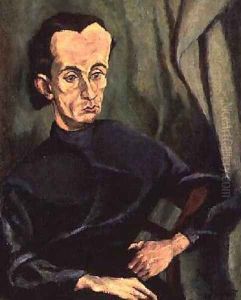Tihonyi Lajos Paintings
Lajos Tihanyi was a Hungarian painter and graphic artist, known to be one of the leading figures in the early 20th-century avant-garde movement in Hungary. Born on October 29, 1885, in Budapest, Tihanyi was a prominent member of the influential group 'The Eight' (Nyolcak), which was formed in 1909 and consisted of progressive artists who were interested in Post-Impressionism and the modern art movements of Western Europe, such as Fauvism and Cubism.
Tihanyi's early works were influenced by the likes of Paul Cézanne and were characterized by solid forms and a restrained palette. As he evolved, his style became more abstract, and he began to incorporate elements of Cubism into his paintings. Despite his experimentation with different artistic styles, Tihanyi never fully abandoned the human figure in his art. His paintings often depicted the struggles of the human condition, with a particular focus on the alienation and isolation of modern urban life.
In addition to painting, Tihanyi was also involved in literary circles and had close connections with writers and poets of his time. This cultural engagement added depth to his work and is reflected in the intellectual quality of his compositions.
The interwar period saw Tihanyi moving to Paris, where he became associated with other Hungarian emigre artists. However, unlike some of his contemporaries who achieved considerable success abroad, Tihanyi lived in relative obscurity and financial hardship. Despite this, he continued to create art that was introspective and innovative.
Lajos Tihanyi's life was cut short when he died on June 11, 1938, in Paris. Although he did not gain widespread recognition during his lifetime, his work has since been appreciated for its contribution to modern art, and he is recognized as a significant figure in Hungarian and European art history. Tihanyi's paintings are held in various collections, including the Hungarian National Gallery in Budapest.
